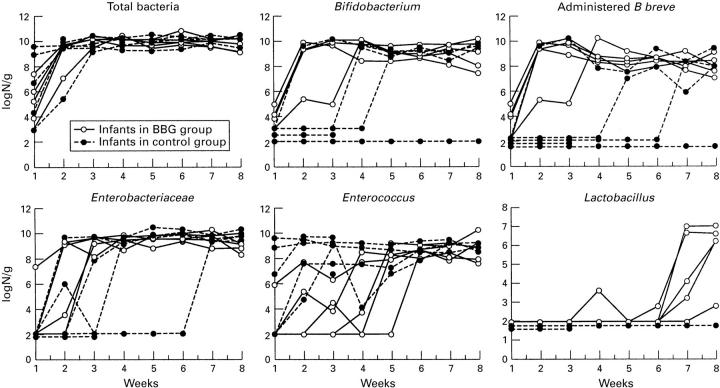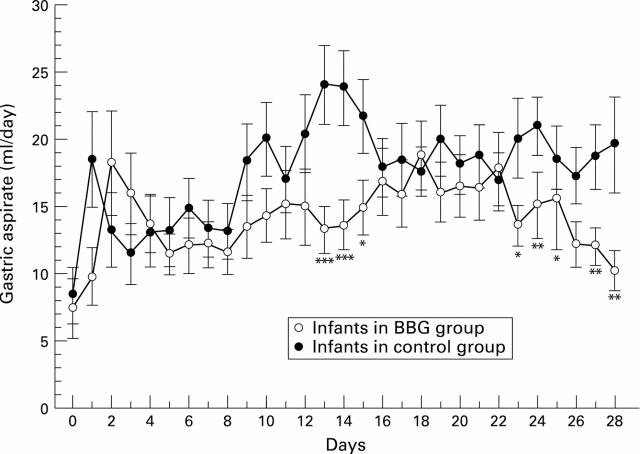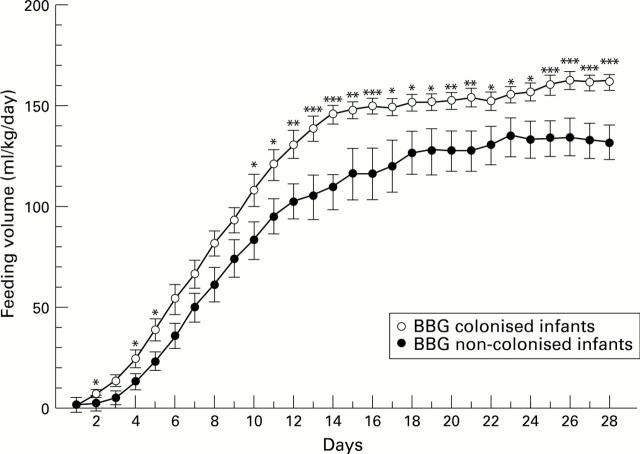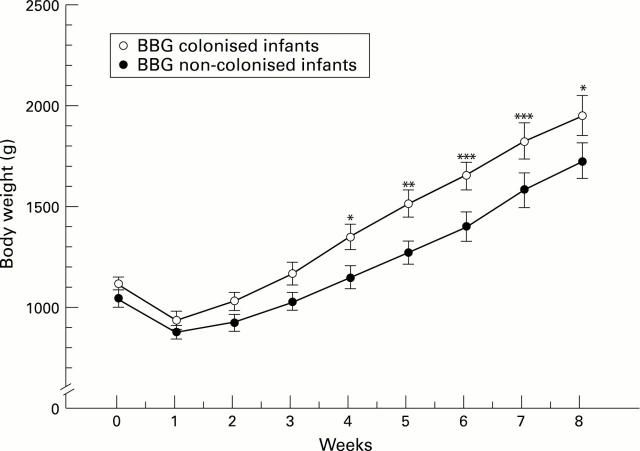Abstract
AIM—To investigate the colonisation with Bifidobacterium breve of the bowels of very low birthweight (VLBW) infants. METHODS—The adverse effects of B breve were examined in 66 VLBW infants (preliminary study). A prospective randomised clinical study of 91 VLBW infants was also completed and these infants were followed up for three years. Precise viable bacterial counts of serial stool specimens were examined for the first eight weeks after birth in 10 infants. The colonisation rates of administered bacteria were examined using immunohistochemical staining of stool specimens with a B breve specific monoclonal antibody. RESULTS—In the preliminary study there were no side effects attributable to the bacteria. Immunohistochemical staining of stool specimens showed that the colonisation rates of the administered bacteria were 73% at 2 weeks of age, but only 12% in the control group. Early administration of B breve significantly decreased aspirated air volume from the stomach and improved weight gain. CONCLUSIONS—B breve can colonise the immature bowel very effectively and is associated with fewer abnormal abdominal signs and better weight gain in VLBW infants, probably as a result of stabilisation of their intestinal flora and accelerated feeding schedules. Keywords: Bifidobacterium breve; stool specimens; necrotising enterocolitis; very low birthweight.
Full Text
The Full Text of this article is available as a PDF (171.8 KB).
Figure 1 .
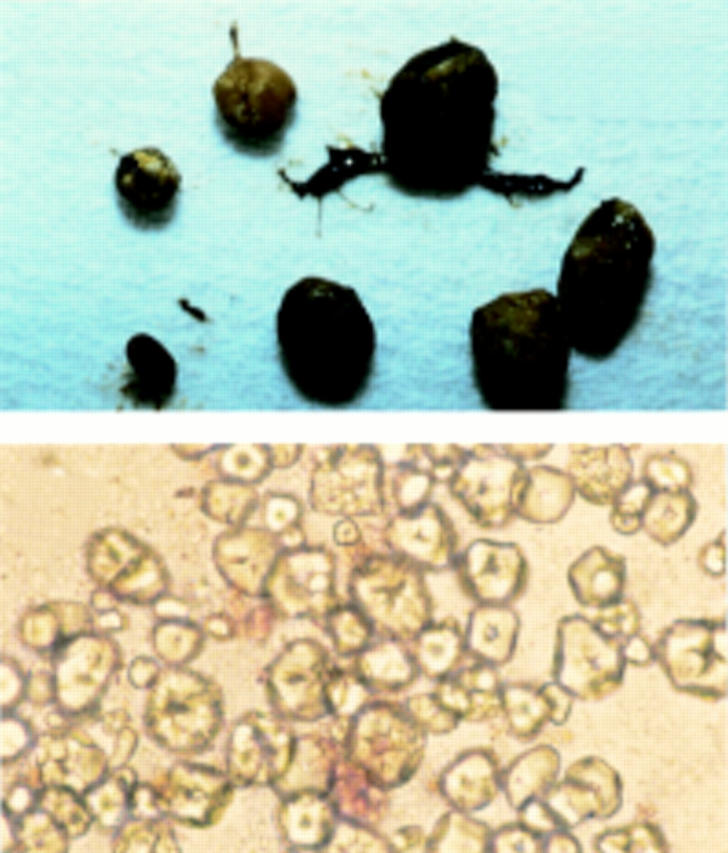

Corn starch aggregates in stool specimen of extremely low birthweight infant (24.4 weeks, 616 g, female): (A) corn starch aggregates in stool specimen; (B) aggregates broken in distilled water (× 400 magnification).
Figure 2 .
Bacterial counts from stool specimens from each infant.
Figure 3 .
Daily changes in aspirated air volume from the stomach. Bars represent mean (SEM): ***P <0.001; ** P <0.02; * P <0.05.
Figure 4 .
Daily changes in feeding volume: bars represent mean (SEM). *** P < 0.001; ** P < 0.02; * P < 0.05.
Figure 5 .
Weekly changes in body weight: bars represent mean (SEM). *** P < 0.001; ** P < 0.02; * P < 0.05.
Selected References
These references are in PubMed. This may not be the complete list of references from this article.
- Bell M. J., Shackelford P., Feigin R. D., Ternberg J. L., Brotherton T. Epidemiologic and bacteriologic evaluation of neonatal necrotizing enterocolitis. J Pediatr Surg. 1979 Feb;14(1):1–4. doi: 10.1016/s0022-3468(79)80567-9. [DOI] [PubMed] [Google Scholar]
- Bennet R., Nord C. E., Zetterström R. Transient colonization of the gut of newborn infants by orally administered bifidobacteria and lactobacilli. Acta Paediatr. 1992 Oct;81(10):784–787. doi: 10.1111/j.1651-2227.1992.tb12103.x. [DOI] [PubMed] [Google Scholar]
- Cicco R., Holzman I. R., Brown D. R., Becker D. J. Glucose polymer tolerance in premature infants. Pediatrics. 1981 Apr;67(4):498–501. [PubMed] [Google Scholar]
- Collins M. D., Jones D. Distribution of isoprenoid quinone structural types in bacteria and their taxonomic implication. Microbiol Rev. 1981 Jun;45(2):316–354. doi: 10.1128/mr.45.2.316-354.1981. [DOI] [PMC free article] [PubMed] [Google Scholar]
- Frantz I. D., 3rd, L'heureux P., Engel R. R., Hunt C. E. Necrotizing enterocolitis. J Pediatr. 1975 Feb;86(2):259–263. doi: 10.1016/s0022-3476(75)80485-9. [DOI] [PubMed] [Google Scholar]
- Fuller R. Probiotics in man and animals. J Appl Bacteriol. 1989 May;66(5):365–378. [PubMed] [Google Scholar]
- Goldmann D. A., Leclair J., Macone A. Bacterial colonization of neonates admitted to an intensive care environment. J Pediatr. 1978 Aug;93(2):288–293. doi: 10.1016/s0022-3476(78)80523-x. [DOI] [PubMed] [Google Scholar]
- Hata D., Yoshida A., Ohkubo H., Mochizuki Y., Hosoki Y., Tanaka R., Azuma R. Meningitis caused by Bifidobacterium in an infant. Pediatr Infect Dis J. 1988 Sep;7(9):669–671. doi: 10.1097/00006454-198809000-00018. [DOI] [PubMed] [Google Scholar]
- Hotta M., Sato Y., Iwata S., Yamashita N., Sunakawa K., Oikawa T., Tanaka R., Watanabe K., Takayama H., Yajima M. Clinical effects of Bifidobacterium preparations on pediatric intractable diarrhea. Keio J Med. 1987 Jul;36(3):298–314. doi: 10.2302/kjm.36.298. [DOI] [PubMed] [Google Scholar]
- Hoy C., Millar M. R., MacKay P., Godwin P. G., Langdale V., Levene M. I. Quantitative changes in faecal microflora preceding necrotising enterocolitis in premature neonates. Arch Dis Child. 1990 Oct;65(10 Spec No):1057–1059. doi: 10.1136/adc.65.10_spec_no.1057. [DOI] [PMC free article] [PubMed] [Google Scholar]
- Jarvis W. R. Epidemiology of nosocomial infections in pediatric patients. Pediatr Infect Dis J. 1987 Apr;6(4):344–351. doi: 10.1097/00006454-198704000-00003. [DOI] [PubMed] [Google Scholar]
- Kliegman R. M., Fanaroff A. A. Necrotizing enterocolitis. N Engl J Med. 1984 Apr 26;310(17):1093–1103. doi: 10.1056/NEJM198404263101707. [DOI] [PubMed] [Google Scholar]
- Lucas A., Cole T. J. Breast milk and neonatal necrotising enterocolitis. Lancet. 1990 Dec 22;336(8730):1519–1523. doi: 10.1016/0140-6736(90)93304-8. [DOI] [PubMed] [Google Scholar]
- Millar M. R., Bacon C., Smith S. L., Walker V., Hall M. A. Enteral feeding of premature infants with Lactobacillus GG. Arch Dis Child. 1993 Nov;69(5 Spec No):483–487. doi: 10.1136/adc.69.5_spec_no.483. [DOI] [PMC free article] [PubMed] [Google Scholar]
- Mitsuoka T., Kaneuchi C. Ecology of the bifidobacteria. Am J Clin Nutr. 1977 Nov;30(11):1799–1810. doi: 10.1093/ajcn/30.11.1799. [DOI] [PubMed] [Google Scholar]
- Sakata H., Yoshioka H., Fujita K. Development of the intestinal flora in very low birth weight infants compared to normal full-term newborns. Eur J Pediatr. 1985 Jul;144(2):186–190. doi: 10.1007/BF00451911. [DOI] [PubMed] [Google Scholar]
- Speer M. E., Taber L. H., Yow M. D., Rudolph A. J., Urteaga J., Waller S. Fulminant neonatal sepsis and necrotizing enterocolitis associated with a "nonenteropathogenic" strain of Escherichia coli. J Pediatr. 1976 Jul;89(1):91–95. doi: 10.1016/s0022-3476(76)80939-0. [DOI] [PubMed] [Google Scholar]
- Stansbridge E. M., Walker V., Hall M. A., Smith S. L., Millar M. R., Bacon C., Chen S. Effects of feeding premature infants with Lactobacillus GG on gut fermentation. Arch Dis Child. 1993 Nov;69(5 Spec No):488–492. doi: 10.1136/adc.69.5_spec_no.488. [DOI] [PMC free article] [PubMed] [Google Scholar]
- Stark P. L., Lee A. The bacterial colonization of the large bowel of pre-term low birth weight neonates. J Hyg (Lond) 1982 Aug;89(1):59–67. doi: 10.1017/s0022172400070546. [DOI] [PMC free article] [PubMed] [Google Scholar]
- Tanaka R., Mutai M. Improved medium for selective isolation and enumeration of Bifidobacterium. Appl Environ Microbiol. 1980 Nov;40(5):866–869. doi: 10.1128/aem.40.5.866-869.1980. [DOI] [PMC free article] [PubMed] [Google Scholar]
- Tojo M., Oikawa T., Morikawa Y., Yamashita N., Iwata S., Satoh Y., Hanada J., Tanaka R. The effects of Bifidobacterium breve administration on campylobacter enteritis. Acta Paediatr Jpn. 1987 Feb;29(1):160–167. doi: 10.1111/j.1442-200x.1987.tb00024.x. [DOI] [PubMed] [Google Scholar]
- Yoshioka H., Iseki K., Fujita K. Development and differences of intestinal flora in the neonatal period in breast-fed and bottle-fed infants. Pediatrics. 1983 Sep;72(3):317–321. [PubMed] [Google Scholar]



